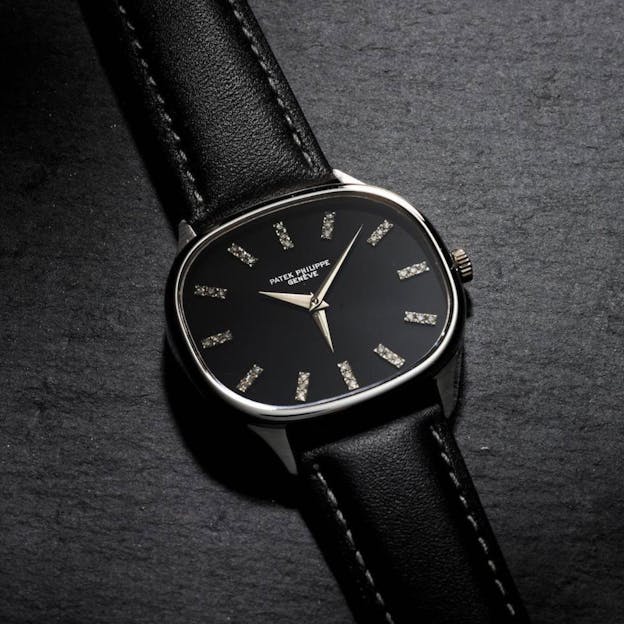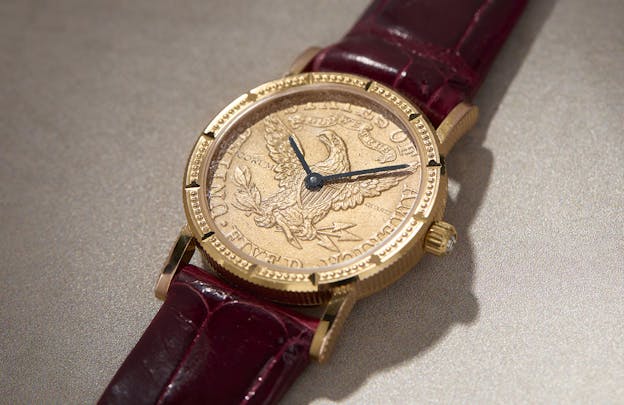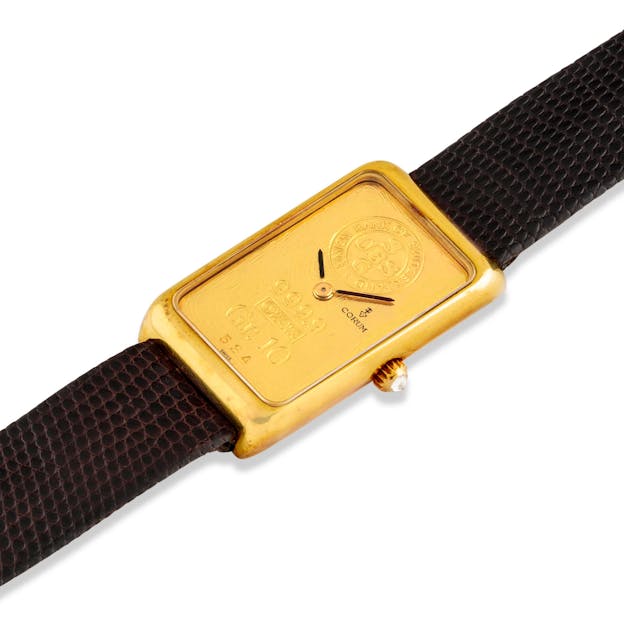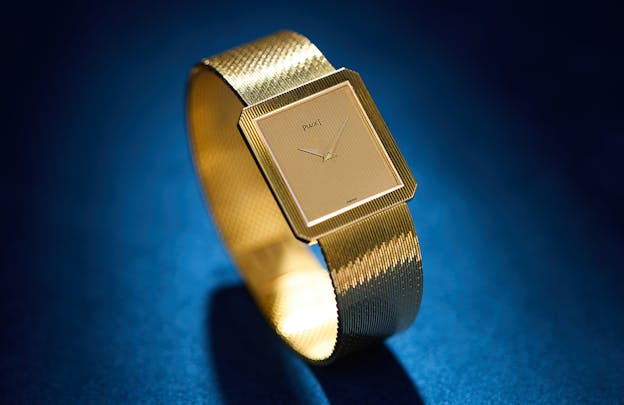Geezer Watches: Eccentric Vintage Timepieces for the Modern Collector
The unconventional world of “geezer watches,” where flamboyance meets legacy in precious metals, eccentric designs, and unapologetic swagger.
In the world of vintage watch collecting, a niche trend has emerged, fondly referred to as “geezer watches.” These timepieces, often crafted from precious metals with integrated bracelets and non-circular dial designs, blur the line between high horology and jewelry. For many years, these watches were seen as small, fussy, and more akin to jewelry than to proper timepieces, but recently there has been a shift in perception. As watch enthusiasts increasingly embrace smaller, more fashion-forward designs, “geezer watches” have found new appeal among collectors.
Many so-called “geezer” are mainly watches from a bygone era, long overlooked and are now being adopted by collectors who missed the inaugural boat ride. There is a level of flamboyance, opulence, and unnecessary bedazzling that literally shines through. But why are they popular now? Is it just the Tik-Tok algorithm blurring the lines between what is collectible vs what is trending? Or is it something deeper in the community’s psyche that is tired of the same integrated steel sports watch design?

I believe it is somewhere in between. People generally buck the trend simply for the sake of rebelling, but thanks to the internet, the appeal of these historically significant and often beautiful watches is finally being appreciated on a mass scale. The other side of the coin is that geezer watches are attainable. There is no fifteen-year waitlist, and are generally affordable (well by luxury watch standards). It is totally doable to grab a gold Piaget with stone dial or an Audemars Piguet TV watch for under $10K.
The truth is, watches are jewelry—regardless of provenance, heritage, or pedigree. If it looks good on the wrist, does it really matter what’s inside? While some may turn their noses up at a quartz movement instead of an in-house caliber, the appeal of most geezer watches lies in their design, not their horological significance. Of course, there are exceptions, such as Audemars Piguet’s ref. 25643, which debuted at the 1986 Basel Watch Fair as the world’s thinnest automatic wristwatch with a tourbillon—the smallest and lightest ever made, and the first to feature a front-facing tourbillon cage. Similarly, Piaget is known for its ultra-thin caliber 9P and 12P movements, which are nothing to dismiss lightly.
But what many of these geezer watches may lack in technical achievement, they more than make up for in design. It’s a delicate balance, and every collector has their own perspective on what defines a “correct” collection, though in reality, there’s no one right answer.
History of “The Geezer”

The term “geezer” isn’t some new invention of Gen Z—it has roots in Old English, where it’s traditionally defined as an old, eccentric man. The irony of using this term to describe trendy, fashion-forward watches is hard to miss. “Geezer” seems to have evolved from the now-obsolete word “guiser,” which referred to someone in disguise, like a performer in a masquerade. Back in medieval times, it was used to describe mummers—actors who performed in silent, traditional plays. The first known literary use of “geezer” dates to 1885 in Corin’s The Truth About the Stage, where he wrote, “In the right-hand division lay the two old geezers, as Sandy styled the landlord and his wife.”
Over time, the meaning shifted. When it comes to watches, we can credit collectors like Phil Toledano (Misterenthusiast on Instagram) and Mike Nouveau for giving “geezer” a new life. As Toledano explained, “I introduced the term geezer to Nouveau, and then (though I’m not sure exactly when) he—or we—started calling all my weird ’70s watches ‘geezer watches.’ Like any inside joke, it’s hard to trace the exact origins, but it was definitely the two of us who started using it in the watch world.”

Through their influence, these two collectors have redefined geezer from a label for something old and unstylish to a badge of honor for watches that are now considered both fashionable and unique.
When asked how he’d describe or define a geezer watch, Toledano gave a memorable response: “It’s like porn—you just know it when you see it.”
The Generational Watch Collecting Divide
As a collector I am stuck between two very distinct generations of watch enthusiasts. There is what I call the “old guard” — Essentially anyone born before 1980 (my apologies if I just offended you). I have a lot of respect for this collector. They laid the groundwork and foundation for watch collecting as we know it. They literally wrote the books on watch collecting and are the primary reason for the democratization of horological history and education. They coined the phrase “buy what you love.” This group tends to be more reserved in their collecting styles and generally follow trends. When watches got big in the late 90’s through the early 2000’s they strapped those Panerai’s and Breitling’s to their wrists with the utmost joy. And now they are following the trends back to smaller watches and setting the market.
Then there is this “new watch order” — this new guard of collectors. Mainly affluent Gen Z social media hounds who push against popularity for the sake of polarization. Who gravitate to what can garner attention, show some panache and flash, and rarely embody the classical ideals of “stealth wealth.” — Obviously, this is a generalization.
A major similarity between the old guard and the new watch order is that they both desire brand recognition. Yes, we have seen a surge in the microbrands and independents that lack historical reverence, but still the big players in the watch game stand tall. Omega, AP, Patek, Rolex, Vacheron, Breguet, Cartier, JLC, and Blancpain are all watch brands that command historical significance. Provenance is an old man’s game, but with provenance comes a hefty price tag. One way to skirt this is to go after the once overlooked vintage pieces that sell for fractions of their original price tag. Enter — the geezer watches.
This new wave of aspirational collectors has gravitated toward a previously overlooked category of timepieces: refined, design-driven watches from the ’70s and ’80s. The 1970s, known for flared bell bottoms and polyester suits, also marked the onset of the quartz crisis, which shifted focus from movements to bold design experimentation. In many ways, this modern shift in watch collecting back to these designs was inevitable, fueled by the modern homogenization of watches and the oversaturation of online content.
As well, there’s a contrarian spirit behind the rise of geezer watches. In a world where new watch releases come at a rapid pace, it was only a matter of time before this trend took hold. After all, how many Royal Oaks and Nautiluses can one admire before the appeal wears thin? Collectors’ tastes began to lean toward something different, something that stood out. As any seasoned collector knows, boredom inevitably sets in after a while. The constant desire for novelty in the collector community has finally caught up, leading to the resurgence of these distinct, often overlooked timepieces.
Like most rising trends, the geezer watch isn’t strictly defined by specific models or reference numbers. Instead, it’s more about embracing a certain attitude and aesthetic. Still, some patterns emerge. Think of pieces like the Vacheron Constantin 222, the Piaget Polo, the AP Cobra (a long-forgotten Genta design), or even a vintage Omega Constellation with a fluted bezel — these all fall squarely into the geezer category. Perhaps the easiest test for spotting a geezer watch is whether you could picture it adorning the wrist of Joe Pesci in Goodfellas or Michael Caine in Get Carter.
Geezer Honorable Mention – Corum

Before I dive into the Prince and Lord of Geezer Manor I feel it’s important to discuss an often overlooked player in the eccentric greasy old man game of geezer’s. “The key to perfect time” has been Corum’s mantra since it burst onto the scene in La Chaux-de-Fonds, Switzerland, back in 1955. Founder Gaston Ries and his designer nephew René Bannwart were on a mission to shake up the watchmaking world, and they certainly did by crafting unique coin watches from $20 gold pieces.
The Corum Coin is probably the best known Corum. Interestingly enough it was the introduction of sapphire crystal in the 60’s, which became the catalyst for the development of this timepiece. The first “Coin” was created and registered in 1964, the model gained immediate attention, with the first 12 pieces selling out before even being showcased at the 1965 Basel Fair. The Coin used in the design is named the “Double Eagle,” despite featuring just a single eagle. This name was chosen to distinguish the $20 coin from the $10 version, which is simply called the “Eagle.”
And to clarify — yes, actual gold coins were used. These geezer watches jump off the wrist, are an immediate talking point.

But Corum wasn’t content to stop there. In their relentless quest for distinction, they launched the Swiss Ingot collection—a true golden opportunity for collectors. These beauties featured cases made from 18k or 24k yellow gold ingots, available in 5, 10, or 15 gram sizes, and featured both quartz and manual variants. Some even got a dash of sparkle with diamonds.
Ingot — which literally means bar of metal, is the definition of opulence. This is the bling bling before bling bling was a thing. This is being iced out, being crispy, or whatever the kids say today before it was a thing. This is the kind of power move you expect from Xerxes all the way to Frank Lucas. A middle school science teacher isn’t pulling this off. You are strapping a gold bar to your wrist, and not just any gold bar, but one that has the Bank of Switzerland insignia stamped on it.
The Prince of The Geezers

Essentially any 70’s AP, VC, and especially Piaget can be considered in some form or fashion a geezer watch — but I think in this exercise it’s important to narrow it down. In reality they all hold some solid horological merit while also providing the wearer and onlookers a sense of flamboyant awe-inspiring panache that causes us all to wanna funnel tomato sauce into our gullets and sing “That’s Amore!” at the top of our lungs.
But Piaget has a little extra panache — their bracelets and their dial shapes are unlike many others in the high fashion and high horology. Their watches aren’t just horologically significant but what we are learning today is they are transcending generations with their outside the box designs proving style and fashion are not just cyclical but dependent upon the wearer. If there is anything I have learned working in this industry is that beauty, appeal, and timeless classics have absolutely nothing to do with the actual design or the observer, it is all about the wearer. I feel geezer watches teach us this. They teach us that if the person has confidence — if they have some swag to their ego — then the watch will echo that, no matter what that watch is. Confidence is style. And one needs confidence to wear a geezer watch.

Piaget, long celebrated for its expertise in crafting ultra-thin movements and jewelry-grade timepieces, has earned its reputation as the “Prince of Geezer Watches.” (This is the title I gave them and is in no way official).
Piaget’s ability to merge watchmaking precision with jewelry craftsmanship, particularly in models like the Altiplano ref. 9154 B12, makes it a prime example of a geezer watch purveyor. With its integrated gold mesh bracelet and striking cube-rectangular case, the 9154 B12 is emblematic of Piaget’s signature flair for combining sleek, sophisticated design with a touch of eccentricity.
Piaget’s pieces, with their distinctive blend of elegance and boldness, perfectly capture the spirit of the geezer genre — one that values an effortlessly cool demeanor over the flashiness of modern sports watches. Just as Piaget carved its niche as a pioneer in ultra-thin movements, it now finds itself at the forefront of the geezer trend, crafting the kind of vintage jewelry watches that evoke a sense of nostalgia, quiet luxury, and timeless cool. Whether it’s Robert De Niro in Casino or a retired executive at a swanky cocktail party, Piaget watches define what it means to wear your legacy on your wrist. Hence, Piaget truly reigns as the “Prince of Geezer Watches.”
The Lord of the Geezer Manor

During the 20th century, Patek Philippe crafted many of its watches with jewelry-like bracelets, tapping into the cultural moment when wristwatches became more than just functional—they became statements of style. The brand collaborated with some of the finest bracelet makers of the era. Among the most renowned is Gay Frères, whose legacy endures today. However, other artisans also contributed, including Jean Pierre Ecoffey, whose beautifully crafted mesh gold bracelets remain highly coveted by collectors and enthusiasts alike.
Despite “just” being a round watch the Patek Philippe Calatrava ref. 3520 on its gold mesh bracelet is about as geezer as they come. This watch has its own vibe — the way a VC 222 gives off the I need a fresh Cuban cigar in a hot tub overlooking south beach kind of vibe — this is the wide lapel, colorful pocket square, greased back hair, boardroom winner, wine cellar enthusiast kind of vibe.

And it doesn’t always have to be yellow gold for a geezer watch. White gold has its place as well.
The Patek Philippe Gondolo Serata 4972/1G-001 is a refined dress watch that was part of the Gondolo collection, known for its Art Deco-inspired pieces. The Serata features a white gold tonneau-shaped case measuring 27.4 mm by 39.7 mm. This elegant shape is enhanced by 130 brilliant-cut diamonds surrounding the case. The diamonds swirl around the outside bezel in a wave pattern that is absolutely mesmerizing. They play with the light the same way the dial does, which is truly the “pièce de résistance.”

Its white guilloché mother-of-pearl dial, which adds a layer of sophistication and subtle texture. It’s loud and soft at the same time. The dial is complemented by white gold Breguet numerals, maintaining the vintage aesthetic for which Patek Philippe’s Gondolo line is known.
The fluid white gold bracelet enhances the watch’s jewelry-like appeal, making it as much an accessory as it is a functional timepiece. With its diamond setting, intricate dial, and vintage design cues, the Gondolo Serata 4972/1G-001 stands as a testament to Patek Philippe’s ability to merge artistry and horology in the feminine form but for all wrists.
These two, quite opposite watches in not only style and color but also highlight why Patek is the true “Lord of the Geezer Manor.”
Taking it Back
With the democratization of watch scholarship, the influence of social media, the cycle of styles, the growth of vintage watch-selling platforms, and the natural evolution of watch design all coming together at this moment in history, we have seen this new pillar of vintage watches come to prominence. Yes, we could thank the likes of Mike Nouveau, Eric Wind, Adam Golden, Gai Gohari, and of course Phil Toledano for the attention these watches are getting, but for me, it is the fact that this trend feels like a genuine appreciation for what is different, and not just what is always historically or horologically significant.
In a hobby that is truly all about the details, what I find a love and appreciation of geezer watches is it allows the collector to ask themselves — does this look good on me? Not does it look good in general? Not if it’s a timeless design, if it has a co-axial, had a tourbillon, won some record, was the first to accomplish something, worn by someone famous — all these axioms we use to justify spending an absorbent amount of money… Geezer watches remind us why we love watches.
Geezer watches are not for everybody and they were never meant to be. These were not meant to be everyday wear. They were not meant to be tool watches, graduation gifts, retirement pieces. They were meant to make a statement. They are expressions of self, callbacks to moments in history, they are what I believe we strive to be in wearable form. I mean no one wears a Piaget Polo or VC 222 without knowing they have a little Sonny Corleone buried deep down under that Patagonia vest, while they ride the 4 train downtown.


